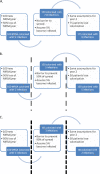To screen or not to screen for methicillin-resistant Staphylococcus aureus
- PMID: 20071548
- PMCID: PMC2832433
- DOI: 10.1128/JCM.02516-09
To screen or not to screen for methicillin-resistant Staphylococcus aureus
Abstract
There are few more compelling questions in clinical microbiology today than the issue of whether or not to screen for the presence of methicillin-resistant Staphylococcus aureus (MRSA), with the results being used to institute infection control interventions aimed at preventing transmission of MRSA in health care environments. Numerous different matters must be addressed when considering a screening program. Who is to be screened, what method is to be employed to detect MRSA, and what sites should be sampled? When and how often should the screening be performed? Who is going to pay for the screening, and, finally and perhaps most importantly, how are screening results to be communicated to health care providers and what kind of interventions are best undertaken based on the results? Numerous governmental agencies have mandated MRSA screening programs, and yet several authorities in infection control organizations have questioned the appropriateness of mandated screening. In this Point-Counterpoint feature, Dr. Lance Peterson of Evanston Hospital (Evanston, IL) offers his perspective on why screening for MRSA is to be encouraged. Dr. Daniel Diekema of the University of Iowa Carver College of Medicine (Iowa City, IA) offers an opposing view.
Figures
Similar articles
-
Usefulness of weekly methicillin-resistant Staphylococcus aureus screening.Infect Control Hosp Epidemiol. 2009 Nov;30(11):1113-5. doi: 10.1086/644753. Infect Control Hosp Epidemiol. 2009. PMID: 19780674
-
Polymerase chain reaction screening for methicillin-resistant Staphylococcus aureus and contact isolation.Am J Infect Control. 2009 Sep;37(7):601-2. doi: 10.1016/j.ajic.2008.10.023. Epub 2009 Jan 31. Am J Infect Control. 2009. PMID: 19181426
-
Screening for methicillin-resistant Staphylococcus aureus: a comparative effectiveness review.Am J Infect Control. 2014 Feb;42(2):148-55. doi: 10.1016/j.ajic.2013.07.020. Epub 2013 Dec 19. Am J Infect Control. 2014. PMID: 24360519 Review.
-
5 years of experience implementing a methicillin-resistant Staphylococcus aureus search and destroy policy at the largest university medical center in the Netherlands.Infect Control Hosp Epidemiol. 2009 Oct;30(10):977-84. doi: 10.1086/605921. Infect Control Hosp Epidemiol. 2009. PMID: 19712031
-
Has decolonization played a central role in the decline in UK methicillin-resistant Staphylococcus aureus transmission? A focus on evidence from intensive care.J Antimicrob Chemother. 2011 Apr;66 Suppl 2:ii41-7. doi: 10.1093/jac/dkq325. Epub 2010 Sep 18. J Antimicrob Chemother. 2011. PMID: 20852273 Review.
Cited by
-
Methicillin-Resistant Staphylococcus aureus Control in the 21st Century: Laboratory Involvement Affecting Disease Impact and Economic Benefit from Large Population Studies.J Clin Microbiol. 2016 Nov;54(11):2647-2654. doi: 10.1128/JCM.00698-16. Epub 2016 Jun 15. J Clin Microbiol. 2016. PMID: 27307459 Free PMC article. Review.
-
Detection of methicillin-resistant Staphylococcus aureus by a duplex droplet digital PCR assay.J Clin Microbiol. 2013 Jul;51(7):2033-9. doi: 10.1128/JCM.00196-13. Epub 2013 Apr 17. J Clin Microbiol. 2013. PMID: 23596244 Free PMC article.
-
Multicenter evaluation of the LightCycler methicillin-resistant Staphylococcus aureus (MRSA) advanced test as a rapid method for detection of MRSA in nasal surveillance swabs.J Clin Microbiol. 2010 May;48(5):1661-6. doi: 10.1128/JCM.00003-10. Epub 2010 Mar 24. J Clin Microbiol. 2010. PMID: 20335423 Free PMC article.
-
Nonimpact of Decolonization as an Adjunctive Measure to Contact Precautions for the Control of Methicillin-Resistant Staphylococcus aureus Transmission in Acute Care.Antimicrob Agents Chemother. 2015 Oct 12;60(1):99-104. doi: 10.1128/AAC.02046-15. Print 2016 Jan. Antimicrob Agents Chemother. 2015. PMID: 26459898 Free PMC article.
-
Multidrug-resistant Acinetobacter spp.: increasingly problematic nosocomial pathogens.Yonsei Med J. 2011 Nov;52(6):879-91. doi: 10.3349/ymj.2011.52.6.879. Yonsei Med J. 2011. PMID: 22028150 Free PMC article. Review.
References
-
- Centers for Disease Control and Prevention. 5 December 2009, accession date. Trends in tuberculosis—United States, 2007. Centers for Disease Control and Prevention, Atlanta, GA. http://www.cdc.gov/mmwr/preview/mmwrhtml/mm5711a2.htm
-
- Delorme, T., S. Rose, J. Senita, C. Callahan, and P. Nasr. 2009. Epidemiology and susceptibilities of methicillin-resistant Staphylococcus aureus in northeastern Ohio. Am. J. Clin. Pathol. 132:668-677. - PubMed
-
- Edmond, M. B., J. F. Ober, and G. Bearman. 2008. Active surveillance cultures are not required to control MRSA infections in the critical care setting. Am. J. Infect. Control 36:461-463. - PubMed
-
- Grayson, M. L., L. J. Jarvie, R. Martin, P. D. Johnson, M. E. Jodoin, C. McMullan, R. H. Gregory, K. Bellis, K. Cunnington, F. L. Wilson, D. Quin, A. M. Kelly, and the Hand Hygiene Study Group and Hand Hygiene Statewide Roll-out Group, Victorian Quality Council. 2008. Significant reductions in methicillin-resistant Staphylococcus aureus bacteraemia and clinical isolates associated with a multisite, hand hygiene culture-change program and subsequent successful statewide roll-out. Med. J. Aust. 188:633-640. - PubMed
-
- Hacek, D. M., S. M. Paule, R. B. Thomson, Jr., A. Robicsek, and L. R. Peterson. 2009. Implementation of a universal admission surveillance and decolonization program for methicillin-resistant Staphylococcus aureus (MRSA) reduces the number of MRSA and total S. aureus isolates reported by the clinical laboratory. J. Clin. Microbiol. 47:3749-3752. - PMC - PubMed
Publication types
MeSH terms
LinkOut - more resources
Full Text Sources
Other Literature Sources
Medical


